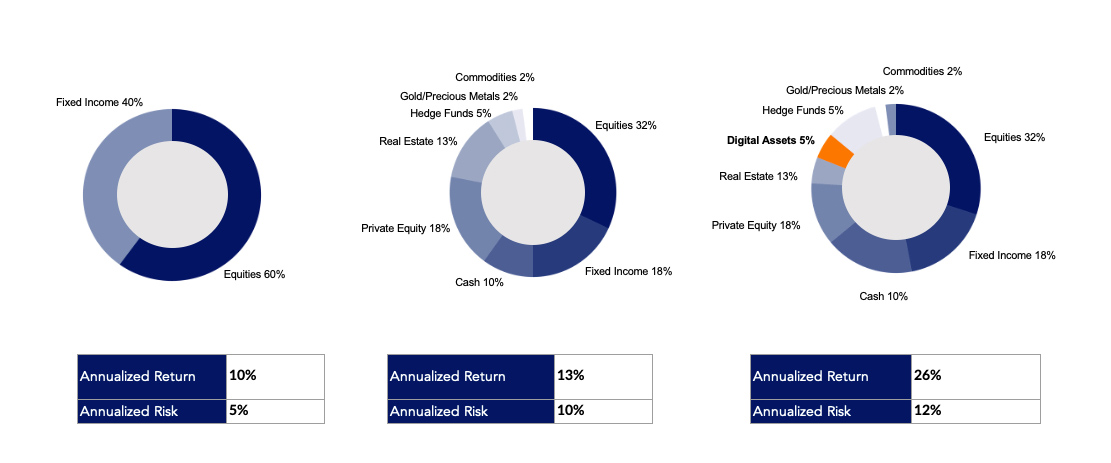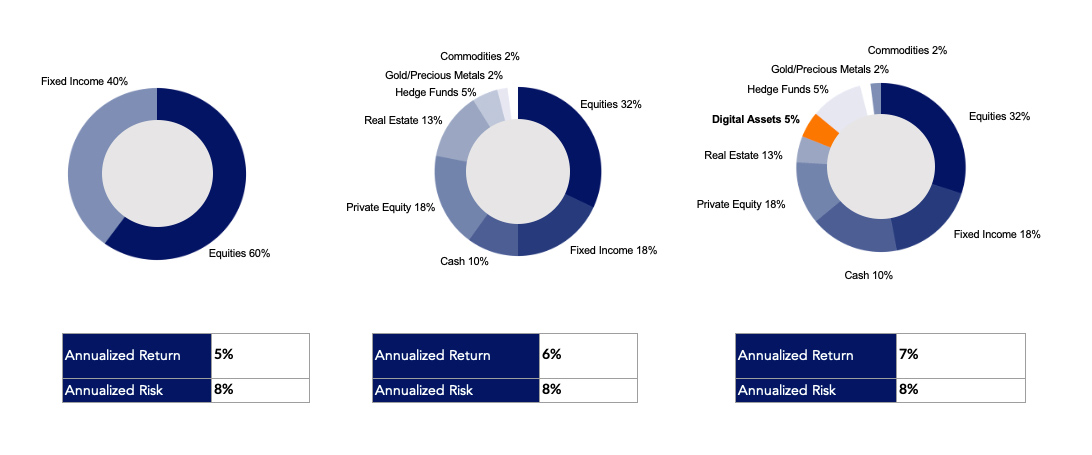The case for including digital assets in your investment portfolio

Digital assets represent an attractive investment opportunity to diversify a family office investment portfolio. This sector represents about $3 trillion of global assets and is poised for further growth. It includes a broad array of investment types: Cryptocurrencies (e.g., Bitcoin and Ethereum), DeFi platforms, decentralized applications, and non-fungible tokens (NFTs).
An increasing number of family offices and ultra-high net worth investors are looking to increase their allocation to this emerging asset class. Key advantages include the accelerated adoption by influential institutions, established diversification benefits and the potential for higher risk-adjusted returns.
The Fidelity Digital Assets survey (2021) indicated that 71% of global institutional investors plan to buy or invest in digital assets, 90% of interested institutions expect to make an investment within next five years and 80% of institutional investors believe digital assets must be part of an investment portfolio. PitchBook also reports that over the past year, venture capital investment into blockchain start-ups has more than tripled.

The number of cryptocurrency users is growing at a similar rate as internet users 25-35 years ago. As the internet matured, the benchmark asset (i.e., Google) grew its revenues by 26% on an annual basis. We expect cryptocurrency returns to normalize over the next ten years and achieve a similar annualised growth rate with lower volatility in the future.
As Nobel Prize laureate Harry Markowitz said in 1952, "Diversification is the only free lunch in investing.” Digital assets have historically had low correlations to traditional asset classes such as global equities. Although Bitcoin has exhibited a higher correlation to equities in recent months, we believe that digital assets will continue to provide strong diversification benefits in the future.
Table 1 Asset Allocations (2016-2021)
For illustrative purposes it is useful to compare the performance of a typical 60/40 portfolio with that of an average family office portfolio and a family office portfolio augmented with 5% digital assets. Over the past five years, the 60/40 portfolio has done reasonably well due to decent returns and low volatility associated with equities and fixed income. The average family office portfolio has had higher returns but with much higher volatility. The best portfolio from a risk-adjusted standpoint was the family office portfolio with 5% digital assets.
Table 2 Asset Allocations (2022-2030)
Going forward, we expect returns in equities and alternative investments to be lower due to mean reversion of valuation metrics. We expect that digital assets will represent 2.5% ($20 trillion) of global investable wealth by 2030. On that basis, a 25% growth rate with a 20% volatility would be a reasonable scenario. Given that our forecast for asset returns in the future will be lower, we expect that the family office portfolio with 5% digital assets will have the highest Sharpe Ratio of the three portfolios.
Sophisticated institutional investors are looking for alternatives to low-yielding bonds and overvalued equities, and digital assets stand out as one of the best options. The question is how to best invest in this asset class. One way would be to simply buy Bitcoin and/or Ethereum and hold them on a long-term basis. A more sophisticated investor could take advantage of niche strategies (e.g., volatility trading) and invest in an actively-managed fund. One should also consider a number of opportunistic venture capital funds that invest in early-stage blockchain companies. The key will be to focus on strategies with high risk-adjusted returns and intelligently diversify your portfolio holdings.








